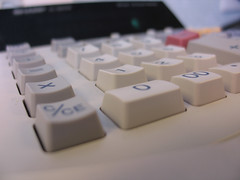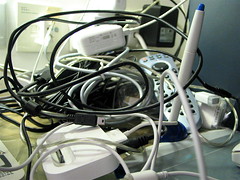Auditing your music collection
March 11, 2015 in digital music by Dan Gravell

"Auditing" is a word that conjures images of accountants, grey suits, briefcases and worst of all... NUMBERS! It's far and away from the kind of thing you want to think about when considering your music collection. Auditing may sound boring, but unless you want a disorganised, inconsistent or corrupted music collection you will have to check for and prevent creeping problems in your music.
Computer music libraries grow organically, from 10s of records, to 100s and then 1000s and sometimes even more. As it gets easier and easier to acquire new music (you don't even need to leave the house now!) the size of your collection is more likely to grow but, pertinently, so is the likelihood of problems. These problems affect the music itself, but also (and probably more commonly seen) the integrity of metadata about the music.
What elements of a music collection can auditing it improve? I start with what I call The Three Cs. Namely, and this is applied to music metadata: completeness, correctness and consistency. Completeness verifies that your metadata is complete, e.g. YEAR and GENRE information exists (as you require it). Correctness verifies that whatever metdata exists is correct. Finally, consistency ensures on a library wide level that metadata is treated and completed in a consistent way so that your music library is as searchable and navigable as possible. An example of this is ensuring you keep a manageable number of genres to browse.
In addition, you should also consider the possibility of creeping data loss or corruption in the audio files themselves. Virii or accidental corruption of music files by errant software or hardware may go unnoticed... until you want to play some particular music at a party. Everyone turns to you to wait for you to spin some old classics but... nothing is heard (aside from your rather embarrassed apologies).
How did it get like that in the first place?
One cause of music metadata problems is that, with so many possibilities for places to acquire music, different sources of music have different standards by which their metadata is completed. Some music sources may categorise genre in different ways, some might have different standards of album art.

Different sources have different standards, but when you also consider your own standards, things become difficult to manage. If, for example, you select and play music on a large TV you may want high resolution album art. Any new music purchased must have its album art re-imported in high resolution versions. Not all online music sources will have such high resolution art.
There's also your own whims. 'Music tagger' software helps us change the metadata in our music files, but this power comes at a price. It's easy to introduce inconsistencies of how different tags are treated. Genre is a good example of this. Before you know it, you can have a sprawl of different genres in your music collection, which makes browsing by genre a long and difficult task.
Finally, consider the possibility of corruption and data loss. There are many possible causes of this: intentional hacking or virii, hardware or software failure. Unlike metadata problems, often you don't realise your audio files have a problem until you try to play them back.
So how can I audit my music collection?
I think your process should be whatever works for you. Personally, I spot issues and fix them as-and-when. Other people may prefer a yearly 'spring clean' of your music library.
When you find something you want to fix, there are tools to help you with the fixing. For metadata issues, the Swiss Army Knife of tools are music taggers . Music taggers display your music files and their tags, allowing you to change the tags within your music files and thus change how your music is navigated. If you don't like the title of albums, this is where you can change it. Popular music taggers include MP3Tag and Jaikoz.
Music taggers are powerful but they don't help with certain aspects of your metadata. Consistency of how your tags are used, for example, is hard to manage. Not in the sense of actually writing the tags (this is what music taggers are for) but for deciding what the tag should be. A music tagger will allow you to do what you like, even if it's the wrong thing for your libraries' consistency.
Instead, you should establish rules by which your music library is constrained. For instance, consider:
Album art
- Must be at least 300x300
- Must be embedded
- Only JPG
Genre
- Choose from one of: Pop, Rock, Classical, Jazz
The rules you choose tend to be influenced by a combination of your own whims and the requirements of your music players.
Rules can be recorded, hand written by yourself, or there is a new breed of rule-based music software encode the rules and apply them for you. This tends to lead to a more consistent music library, and it's also less work to resolve non-compliance.
It's worth using software to check for damaged audio files. There's a variety of software available to perform these checks. Pointed at the root folder of your music library, it should scan all of your music files and report problems for repair or re-acquisition (e.g. re-ripping a CD is sometimes the only option).
I hear that prevention is better than cure...
Chances are that most degredations and annoyances in your music browsing will be discovered as you search through your music for something to play, or in the case of audio corruption when you play it.
It's possible to be a little more pro-active. By understanding your sources for music you can sometimes know what to expect from the metadata that will be provided. For example, album art of a certain resolution that must be enlarged or shrunk.

An alternative is to use the rules I discussed above when assessing your new music added to your collection. By reading through the rules and comparing the new music for compliance with these rules you can see what might be unwanted before the music is even imported into your music system. Again, automatic rule based music software can help with this.
To guard against malicious damage to your audio files, ensure you take adequate security measures. Install anti virus software, if there's a chance your music library could be infected, and use firewalls to stop outsiders accessing your music files. You not only need to guard your music files, but also the applications that access them. For instance, if you have Web based music management software, the software may allow for deleting files. You must ensure the software is either not accessible to intruders by using a firewall or a username/password challenge.
In addition, it's worth checking regularly for damage to your music files. Software exists to check for and correct this damage, so running it every so often gives you a better chance of finding and fixing problems early.
When the worst happens
The absolute minimum you should do is backup your music collection. If the worst does happen and your music library is deleted or corrupted, there can be little other recourse other than restoring your last good copy.
Backups are your 'backstop'. They are not only good in cases of data loss, they are also useful in any other scenario where there is no fix, or no practical fix. For instance, imagine you accidentally changed every album name in your music collection to the same name. You could go through and change them all back, but it's probably easier to just restore your last backup.
Don that suit, adjust your tie, we're going auditin'!
I hope I've convinced you that auditing your music collection is a worthwhile pursuit, and given you some good ideas as to your first steps. Ask any questions you have in the comments section below!
Thanks to Tracy O, denn and jfcherry for the images above.

